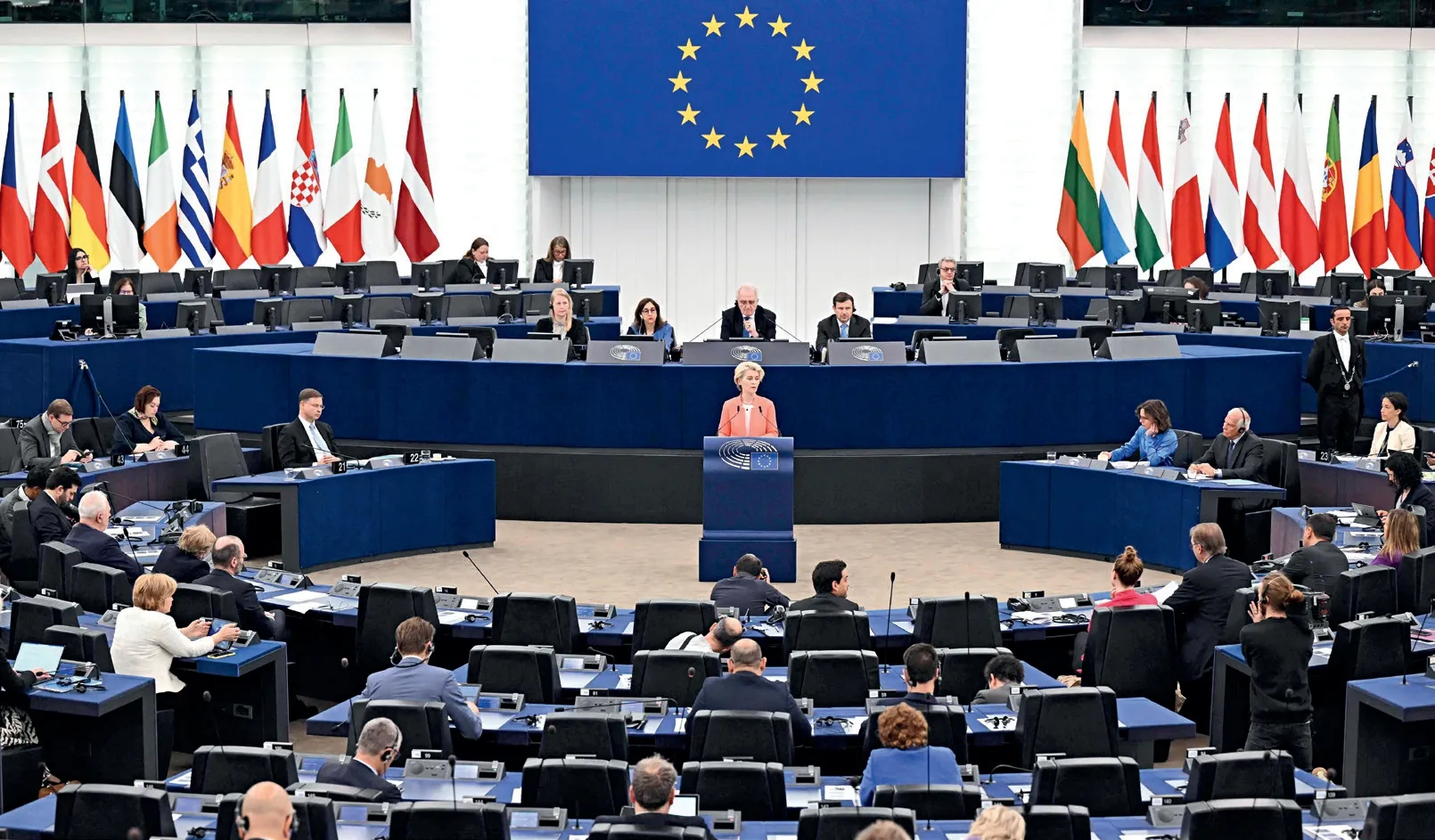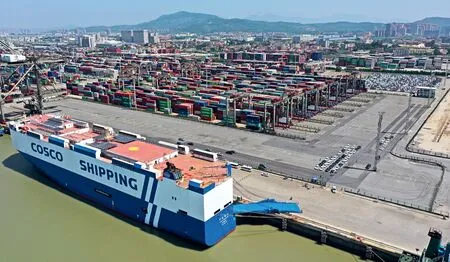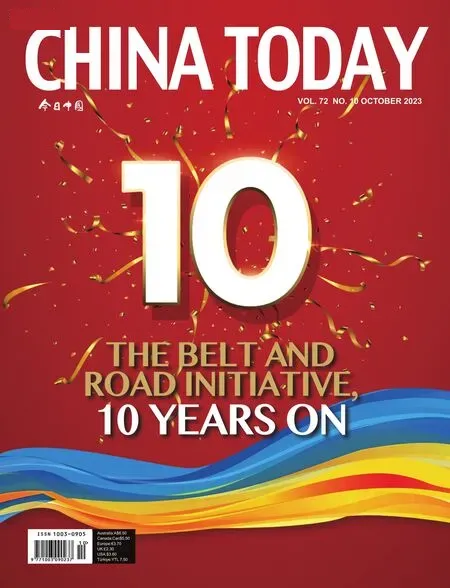New Challenges and Opportunities for China-Europe Belt and Road Cooperation
By HU HONG

European Commission President Ursula von der Leyen speaks during a debate on the need for a coherent strategy for EU-China relations,as part of a plenary session at the European Parliament in Strasbourg,eastern France,on April 18,2023.
For China-Europe relations,which have developed for more than seven decades,the Belt and Road Initiative has become a new platform providing fresh impetus to their cooperation.
T HE year 2023 marks the 10th anniversary of the Belt and Road Initiative (BRI).On the principle of extensive consultation,joint contribution and shared benefits,this initiative has become an effective mechanism for China and other participating countries to promote policy coordination,connectivity of infrastructure and facilities,unimpeded trade,financial integration,and closer people-to-people exchanges.
For China-Europe relations,which have developed for more than seven decades,the BRI has become a new platform providing fresh impetus to their cooperation.However,the turbulence of the global geopolitical situation and the tough policies of some European countries toward China,under the influence of hegemonism and a zero-sum game mindset,have cast a shadow over China-Europe relations in the past few years.This also hindered China and European countries from furthering their cooperation under the BRI,or unleashing the potential of Asia-Europe connectivity.
Fruitful Cooperation
When it comes to the achievements of China-Europe cooperation under the BRI,the China-Europe freight train is the most notable.Since the first freight train departed from Chongqing in March 2011,the railway line has witnessed more than 73,000 trips made by the trains,transporting 6.9 million TEUs of goods as of the first half of 2023.
At present,the transportation service network has basically covered the entire area of Eurasia.In the first half of this year,the freight trains made 8,641 trips and transported 936,000 TEUs of goods,an annual increase of 16 percent and 30 percent,respectively.
In the past few years,neither the COVID-19 pandemic nor the declining global demand has been able to prevent the sustained and stable growth of trade along the China-Europe freight railway,which has become the primary choice for international logistics and transportation between China and Europe.It also emerged as an important stabilizer for China-Europe trade and cooperation.
The development of the China-Europe freight trains is the epitome of Asia-Europe connectivity and the construction of the BRI.Over the past decade,China and Europe have also made great progress in the connectivity of policy,infrastructure,trade,capital and people-to-people exchanges under the BRI.From freight trains to revitalized ports,cross-sea bridges,vaccine factories,the digital economy,and green growth,China and Europe have advanced cooperation across the board.
At the policy level,China has signed memorandums of understanding,protocols and agreements with 26 European countries on BRI construction.Bilateral and multilateral exchanges involving connectivity of transportation,customs,trade and agriculture at the ministerial level have also been carried out frequently.
In terms of infrastructure,the Port of Piraeus in Greece and the Hungary-Serbia Railway are the flagship projects of China-Europe cooperation under the BRI.The Pelješac Bridge in Croatia,which offi-cially opened to traffic in 2022,is the first European Union-financed project built by a Chinese enterprise through bidding.It is also the largest single project financed by an EU fund and undertaken by a Chinese enterprise,demonstrating a new model of infrastructure cooperation between China and Europe.
Trade and finance,two pillars of China-Europe economic and trade ties,have also benefited a lot from the BRI.From 2016 to 2021,China’s imports from the European Union increased by 63.7 percent,and imports from Central and Eastern Europe surged by 127.3 percent.The increase effectively alleviated the long-standing trade imbalance between China and Europe.
European financial institutions are also actively involved in the construction of the BRI.Deutsche Bank released a BRI white paper in 2019,while Commerzbank signed a memorandum of understanding with the Industrial and Commercial Bank of China on BRI cooperation in 2018,and agreed on principles of green investment under the BRI in the following year.
People-to-people exchanges between China and European countries have been also deepened.Tourism and exchanges between universities and think tanks advanced China-Europe cooperation under the BRI.Europe has always been one of the top destinations for Chinese students and tourists.After the COVID-19 travel restrictions were lifted,the governments of China,France,Italy and Spain seized the opportunity of a bilateral cultural and tourism year to promote exchanges in arts and sports.The works of European master painters and artists were exhibited in China,attracting large numbers of Chinese visitors.China is also taking the opportunity of the Beijing 2022 Winter Olympics to promote sports cooperation with Italy,host of the next Winter Olympics,and France,host of the Summer Olympics in 2024.
In addition,the BRI has brought tangible benefits to enterprises and cities along the route,and has generated positive spillover effects.The China-Europe freight railway passes more than 300 cities in 26 countries.These cities have enjoyed the benefits brought by the BRI,and driven regional economic prosperity and employment growth.
The vast number of developing countries along the route have benefited from the cooperation between China and Europe under the BRI,as cooperation in a third-party market under the BRI has become an important part of China-Europe cooperation.
China has established third-party market cooperation mechanisms with France,Italy,Spain,Belgium and other EU countries.Under this mechanism,China’s advantages of production capacity,and strengths in equipment and engineering construction are combined with European countries’ advantages of core technical equipment and market management experience to meet the industrialization and modernization needs of developing countries in Central Asia,Africa and other regions through the BRI.The mechanism has promoted economic and trade cooperation beyond the bilateral level,and generated a win-win outcome.
Furthermore,with the connection of the China-Europe freight railway with regional transportation projects in Asia,including the China-Laos Railway,transportation connectivity between China and Europe will bring new momentum to regional development and the construction of the BRI.
New Challenges and Opportunities
Despite a good start,due to the impact of the COVID-19 pandemic and the Russia-Ukraine conflict,China-Europe cooperation under the BRI encountered major obstacles,and it is urgent to regain momentum for the cooperation.
The outbreaks of the pandemic and the Russia-Ukraine conflict not only seriously disrupted regional stability and supply chains,but also caused intensified geopolitical situation.In this process,mutual perception between China and Europe has become increasingly negative in the past few years,and mutual trust has been damaged.Some European officials and scholars said that the reliability and predictability of China’s political,economic,and security policies are on the decline,whereas Chinese officials and academics believe that Europe mistakenly views China as a systemic competitor,and that instead of staying strategically independent,Europe follows the United States in suppressing China and adopts no pragmatic policies toward China.
These perceptions complicated the situation,and brought new challenges to the cooperation between China and Europe on promoting the BRI and Asia-Europe connectivity.One of the most prominent manifestations of this is the Global Gateway initiative launched by the EU in December 2021.The plan integrates various resources for development assistance in the EU,proposes systematic plans for global connectivity cooperation,and plans to raise 300 billion euros by 2027 to invest in key infrastructure projects in so-called like-minded partner countries in Eastern Europe,Africa,and the Middle East,as well as ASEAN members.
This March,the EU further released a list of cooperation plans under the Global Gateway initiative,involving Africa,Latin America and the Caribbean,and the Asia-Pacific region.It also pledged to devote great energy to building flagship projects in cooperation with countries in western Balkans and its neighboring countries.
The EU’s Global Gateway initiative was launched in the wake of the United States’ Build Back Better World initiative,or the B3W plan.The two initiatives are widely seen as attempts by Europe and the United States to counter the BRI.
When European Commission President Ursula von der Leyen announced the initiative,she said that the Global Gateway initiative would become a real alternative to the BRI.Some recent statements by Italian officials at different levels about possible withdrawal from the BRI also highlight the current negative perception of the BRI in Europe.
These changes are not good for China-Europe cooperation under the BRI nor the construction of Asia-Europe connectivity.Since the BRI was proposed in 2013,European political,business and academic circles have been criticizing it,questioning its motives and the way it is implemented.However,various sectors of Europe are mainly playing the role of a critical partner with the aim of participating in the BRI in a more intensive and productive fashion.This is also an important reason why the BRI bore fruitful results over the past decade.If a zero-sum game mindset were adopted in dealing with China-Europe relations,the multi-trillion dollar potential of the BRI cooperation and Asia-Europe connectivity wouldn’t be unleashed.

The Xiamen Ocean Gate Container Terminal,in southeast China’s Fujian Province,hosts a COSCO ship with over 2,700 domestically produced electric vehicles bound for Europe on July 8,2023.lt is theinaugural journey on the new China-Europe liner route.
Fortunately,both sides are still working to mend the relations.In early August,Chinese Foreign Minister Wang Yi spoke with the High Representative of the EU for Foreign Affairs and Security Policy Josep Borrell.Borrell pointed out that the Global Gateway initiative and the BRI are not in opposing camps,but complement each other.Both of the initiatives aim at promoting global development,said Borrell.Wang also looked forward to making up for the missing exchanges between China and Europe over the three years of the pandemic.With the third Belt and Road Forum for International Cooperation about to start in October of 2023,as well as the frequent meetings between Chinese and European leaders and officials at different levels,China-Europe relations and cooperation under the BRI are also expected to shift back on track.
While posing challenges,the Russia-Ukraine conflict and the COVID-19 pandemic have also brought new opportunities for cooperation under the BRI.The importance of public health in international politics has increased,and the BRI offered a platform for China and Europe to advance cooperation in public health during the pandemic.The experience the two sides gained in cooperation in the health sector can be applied in other fields.In 2020,China and Europe agreed to expand their relations to a green partnership and digital partnership.How to combine these two types of partnership into China-Europe cooperation under the BRI in the next decade is also an issue worthy of in-depth discussions.
As for problems existing in BRI cooperation in the past decade,China and Europe need to pool their wisdom and work out solutions jointly.Problems include lack of transparency in project operation,failure to meet European standards,and barriers in market access.If these problems are solved,a new chapter in China-Europe cooperation under the BRI is just around the corner.
Statistics indicate that by 2040,the gap in global infrastructure investment will reach 13 trillion euros.This huge investment gap offers room big enough for both the BRI and the Global Gateway initiative to play their roles.

